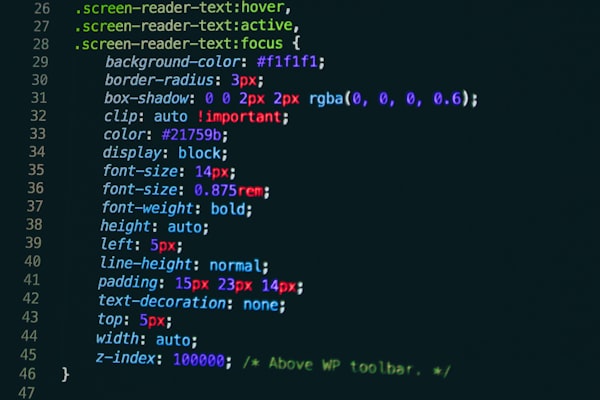1. Overview of Modern CSS Animation Techniques
If you've ever wondered how to add some pizzazz to your web page without resorting to flashing neon banners from the 90s, then boy, do we have news for you! Welcome to the dynamic, high-octane world of Modern CSS Animation Techniques.
The realm of CSS animations, my friends, is a bit like Hogwarts School of Witchcraft and Wizardry: filled with mystery, magic, and just a dash of madness. But unlike He-Who-Must-Not-Be-Named (we're looking at you, outdated HTML marquees), CSS animations are something we definitely want to mention.
CSS animations have come a long way from the days of bouncing logos and spinning images, evolving into a sophisticated tool to enhance user engagement. We're now in an era where you can make your buttons jiggle when hovered over, create a shimmering loading screen that doesn't make your users click the dreaded "back" button, or craft a parallax scrolling effect that will leave your visitors in awe. It's the digital equivalent of learning to create a Patronus, just less stressful and without the Dementors.
Stay tuned as we unravel the mysteries of modern CSS animation techniques, so powerful that even Dumbledore would say, "CSS, you sly dog! You've done it again!" So grab your wands – ahem, I mean keyboards – and let’s conjure some spell-binding animations!
2. Understanding the Basics: CSS Keyframes and Transitions
Look out, dear readers, because we're about to dive into the deep end of the CSS animation pool, but worry not! This isn't the monster-filled Black Lake from the Triwizard Tournament; this is a welcoming water filled with enlightening insights on CSS Keyframes and Transitions. We've got your gillyweed right here!
In the enchanting world of CSS, Keyframes are your faithful sidekicks, helping you create smooth, detailed animations. Imagine them as the Ron Weasley to your Harry Potter - always there to make your animations journey a little less perilous, a little more thrilling. They're the puppet masters, controlling what happens at each point during the animation timeline. Want to rotate, scale, translate, or skew? Keyframes are your magical incantations, your "Wingardium Leviosa" in the world of CSS animation.
Next up, we have transitions - your personal Invisibility Cloak in the quest for seamless animations. If Keyframes are your Ron, transitions are undoubtedly your Hermione. They're that little extra touch of sophistication, smoothing out the rough edges, turning your animation from a mere website element into an interactive storytelling piece. A transition in CSS is like having Hermione’s Time-Turner, allowing you to control the time duration and easing function of your animation journey.
Whether you're making a simple button hover or constructing an entire animated Hogwarts, understanding the basics of CSS Keyframes and Transitions is vital. By the end of this section, you'll have the confidence to yell "Expelliarmus!" at any dull, static element on your web page.
Stay with us as we explore these foundational spells - I mean, concepts - and who knows? You might just end up being the Dumbledore of CSS animations. Buckle up, because this is one magical ride you don't want to miss!
3. Advanced CSS Animations: An Introduction to CSS Variables
Just when you thought you had mastered your spells, we're here to throw another magical element into the mix. Meet CSS Variables, the Room of Requirement in your castle of CSS animations. Complex, mysterious, yet wonderfully useful - they hold the secret to advanced, customizable, and frankly, stunning animations.
Think of CSS Variables like the Marauder's Map of your CSS codebase. They guide you through your stylesheet, showing you 'who' (which element) is 'where' (which part of the code), at 'what time' (under what conditions). And as any Harry Potter fan knows, the Marauder's Map only works with the correct incantation: "I solemnly swear that I am up to no good." In CSS, you declare your intention to unleash the power of variables by prefixing them with '--'. It's like casting a spell, except you're controlling code, not Cornish Pixies.
CSS Variables bring an unprecedented level of dynamism and reusability to your animations. Want to animate an element with a color that changes based on user interaction? CSS Variables got your back. They're like a Felix Felicis (liquid luck) potion for your animations, making even the most complex sequences feel effortless.
Are you ready to delve into the world of CSS Variables, leaving no stone (or style) unturned? By the end of this journey, you'll be wielding your CSS skills like a true wizard, ready to impress even the Magic Council. So let's unfold the Marauder's Map and start our adventure through the intricate and captivating world of advanced CSS animations!
4. Harnessing the Power of CSS Animation Libraries
Alright, dear magicians of the modern web, it's time to take a trip down to Diagon Alley, but instead of wand shops and broomstick boutiques, we'll be browsing through the fascinating world of CSS Animation Libraries. They're the enchanted tools that can supercharge your animation spells, turning you from a struggling first-year at Hogwarts into a seasoned wizard like Gilderoy Lockhart (only more competent, we hope).
CSS Animation Libraries are like the spellbooks in the Hogwarts library: packed full of ready-to-use spells – I mean, animations – that can be summoned with a simple flick of the wrist (or a line of code). Imagine them as your own personal Professor Flitwick, teaching you Charms 101, but instead of levitating feathers, you're creating seamless, interactive animations.
One such powerful spellbook is Animate.css, a veritable feast of pre-made animations. Want to make your elements bounce, flash, pulse, or rubberband? Animate.css has got you covered faster than you can say "Quidditch"!
Then we have GreenSock, or GSAP, the Advanced Potions class of CSS Animation Libraries. It's robust, it's flexible, it's like brewing your Polyjuice Potion of animations but without the horrible taste.
In this section, we'll guide you through these enchanted aisles of CSS Animation Libraries, helping you choose the right tool for your task at hand. By the end of it, you'll be harnessing their power like a true wizard, ready to make magic on the web! So, are you ready to expand your horizons and venture into the bustling, dynamic world of CSS Animation Libraries? Because they're ready for you!
5. How to Optimize Performance of CSS Animations
It's time to channel your inner Hermione Granger, because we're about to dive into the nitty-gritty details of CSS Animation performance optimization. Just as Hermione knew the importance of timing and precision in casting spells, so too must we learn the art of optimizing our CSS Animations. We're aiming for the "Wingardium Levi-O-sa", not "Levio-SAH", remember?
Optimizing the performance of CSS animations is like trying to catch the Golden Snitch in a high-stakes game of Quidditch. It can be elusive, challenging, but oh-so-satisfying when you finally grab hold of it. It's about ensuring your animations run as smoothly as a Firebolt broomstick, offering your users a seamless, enjoyable experience.
One of the key components of optimization is understanding CSS Triggers. These are the moments when our spell - I mean, animation - springs into action. By knowing which properties trigger layout changes, paint, or composite layers, we can make informed decisions on how to create our animations. It's a bit like planning your moves in a game of Wizard's Chess - strategy is everything.
Another trick up our sleeve in the optimization journey is using the magical 'will-change' property. It's like a Secret-Keeper Charm for your browser, letting it know in advance what changes are about to occur. This allows the browser to perform necessary optimizations before the animation happens, leading to a smoother animation process.
In this chapter, we'll explore these and other magical techniques to optimize your CSS animations. We're on a quest to make your animations as smooth as Dumbledore's beard, ensuring that every transition, every keyframe, every effect is as seamless as possible. Get ready, because performance optimization is the secret sauce to becoming a master of CSS Animation!
6. Examples of Innovative Uses for CSS Animations
Alright, folks, gather around! It's time for a magical show-and-tell, a journey through the creative landscape of CSS Animations. Imagine we're visiting the Department of Mysteries, delving into the unknown, but instead of prophecy orbs and time-turners, we'll be showcasing innovative examples of CSS animations. They're the real Unspeakables here!
First up, let's talk about interactive storytelling. Websites like Alice in Videoland have harnessed the power of CSS animations to create a fully immersive, interactive experience, turning a simple webpage into a living storybook. It's like stepping into the Hogwarts Library and having 'The Tales of Beedle the Bard' come to life before your very eyes.
Next, we have creative navigation menus. If you thought navigation menus were as boring as watching paint dry on Professor Binns, think again! CSS animations can morph your average menu into a visual spectacle, turning each click into an experience. It's like discovering the Marauder's Map all over again, full of mystery and wonder.
Then there's the magic of data visualization. Websites like Information is Beautiful use CSS animations to bring data to life, transforming dull stats and numbers into interactive, engaging, and digestible information. It's like turning a tedious History of Magic lecture into a thrilling Quidditch match.
In this section, we'll be exploring these and other innovative uses for CSS animations. It's about pushing the boundaries, discovering new magic, and taking your web design skills to the next level. So let's dust off our broomsticks and venture into the captivating world of innovative CSS animation examples. Trust us, it's going to be a blast - and we promise, no Blast-Ended Skrewts!
7. CSS Animations vs JavaScript: A Comparative Study
Welcome, dear readers, to the ultimate magical duel: CSS Animations vs JavaScript. It's like Harry vs Voldemort, Dumbledore vs Grindelwald, or Umbridge vs... well, pretty much everyone at Hogwarts. Let's dive into this battle of the titans, shall we?
In one corner, we have CSS Animations, the champion of simplicity and performance. With its trusty wand of keyframes and transitions, CSS Animations can cast simple to moderately complex spells - I mean, animations - with less processing power. It's like Hermione's trusty Time-Turner, efficient and effective, though it does have its limitations.
On the other hand, we have JavaScript, the master of complexity and control. If CSS is a charming Patronus, JavaScript is the versatile Room of Requirement. Need to animate complex sequences? JavaScript's got your back. It's like the Elder Wand, powerful and capable, but it demands a skilled hand.
While CSS Animations are generally more performant and easier to implement for simple animations (think a Remembrall glowing when you've forgotten something), JavaScript offers more flexibility and control, especially for complex interactions (like the moving staircases at Hogwarts).
In this section, we'll delve into the nitty-gritty of this comparison, casting Lumos on their strengths, and not shying away from their weaknesses. By the end of it, you'll have a solid understanding of when to use which tool, and the confidence to say, "CSS Animations and JavaScript, I can handle both!" So get ready for an exciting duel, and may the best animation technique win!
8. Best Practices for Implementing CSS Animations
Hold onto your sorting hats, wizards of the web, because we're about to divulge the secret rules of the CSS Animations realm. It's like the Hogwarts Code of Conduct, except our rules are more "avoid layout thrashing" and less "don't go into the Forbidden Forest".
Implementing CSS Animations might seem like a walk in the park (or a stroll around the Hogwarts grounds), but without a keen eye for best practices, you might just end up tripping over a tree root. Or worse, getting tangled in Devil's Snare. And we all know how that ends.
First on our list is 'Animation Should Enhance, Not Distract'. This is the golden rule, the 'I must not tell lies' of CSS Animations. Your animations should be like the Whomping Willow, standing out, but not obstructing the path. If your users spend more time watching your animations than reading your content, you're more off track than a Blast-Ended Skrewt.
Next, we have 'Optimize for Performance'. This means keeping an eye on those CSS Triggers, optimizing where you can, and ensuring your animations are as smooth as a well-cast Wingardium Leviosa spell.
And let's not forget 'Accessibility Matters'. Yes, that's right, your animations should be as inclusive as the Hogwarts School itself, ensuring users of all abilities can enjoy your web experience. Remember, Hogwarts accepts all, whether you're a wizard, witch, squib, or muggle!
In this chapter, we'll dive deeper into these best practices, ensuring you're ready to implement your CSS animations like a true master. By the end of this section, you'll have the wisdom of Dumbledore and the skills of Flitwick, ready to create animations that even the Ministry of Magic would approve of! So get ready, it's time to learn the rules, so you can break them like an artist!
9. The Future of Web Design: Predicting CSS Animation Trends
Fasten your seat belts, and secure your broomsticks, dear readers, because we're about to embark on a journey through time and space, straight into the future of CSS Animation trends. It's like gazing into the Hogwarts Pensieve, diving into memories, only this time, we're peering into the future of web design.
The world of CSS Animations is evolving faster than a misfired Transfiguration spell, shaping and reshaping the digital landscapes we encounter daily. The future, though as mysterious as the inside of a Room of Requirement, promises a vibrant tapestry of interactive and immersive web experiences.
One trend we're likely to see is 'Microinteractions'. These are subtle animations that respond to user interaction, like a sorting hat whispering into your ear. Think buttons that depress when clicked, or form fields that jiggle when you forget to fill them in.
Next up, we have 'Dark Mode Animations'. As more and more platforms offer dark mode, we predict that the use of CSS animations that adapt to these changes will be as prevalent as Every-Flavour Beans in a Hogwarts care package.
And then there's the exciting prospect of 'Virtual Reality (VR) and Augmented Reality (AR)'. With the lines between the physical and virtual worlds blurring, CSS animations will play a crucial role in enhancing these immersive experiences. It's like stepping into the magical world of Hogwarts, right from the comfort of your living room.
In this section, we'll explore these trends and more, gazing into the crystal ball of the future of web design. It's going to be a thrilling ride, full of innovation, creativity, and of course, a healthy dose of magic. So let's wave our wands and shout, "Expecto Patronum!" to ward off the Dementors of uncertainty and embrace the bright future of CSS Animation trends.
10. Real-World Case Studies: Effective Use of CSS Animations
Ah, the time has come, fellow web wizards, to step out of our magical CSS Animation bubble and peer into the real Muggle world. Just as the Triwizard Tournament brought challenges from the real magical world, we too are going to delve into real-world case studies of effective use of CSS animations. Grab your Goblet of Fire (or a cup of coffee), and let's get started!
Our first trip takes us to the enchanting world of Airbnb. Airbnb's use of subtle CSS animations on their homepage is as welcoming as the Great Hall's floating candles. The images' smooth transition into the viewport, the hover effects on cards, it's all a harmony of CSS magic, creating an experience as unforgettable as your first Quidditch match.
Next, we apparate to the wizarding world of Stripe. Their use of CSS animations, especially on their products page, is akin to casting a well-executed 'Alohomora'. The animations open up the content, guiding the users through their journey as smoothly as the Hogwarts Express journey on September 1st.
Our last stop is Apple, a giant in both the tech and the animation realms. Their unveiling of new products with smooth CSS animations is like opening the Marauder's Map: "I solemnly swear that I am up to no good". The way elements glide and pop on your screen, it's a spellbinding experience, keeping users engaged and eager for more.
In this section, we'll delve deeper into these case studies, uncovering the CSS spells these companies have cast to create engaging and effective user experiences. It's a thrilling exploration of practical, real-world magic that awaits us, just a Portkey away. So, ready to step into the Floo Network of CSS animations and see where it takes us?








